Results
-
 £75.00
£75.00Aria (from Suite Antique) (Flute Solo with Concert Band - Score and Parts) - Rutter, John - Noble, Paul
Suite Antique is a 1979 concertante work by John Rutter that is written for harpsichord, flute and string orchestra. Rutter composed the piece, in six movements, for a concert at which Bach's fifth Brandenburg concerto was to be performed, and so decided to write the piece for the same ensemble. This arrangement for Concert/Wind Band and Solo Flute adheres to the original presentation, but is expanded for a full band accompaniment to the solo flute. The harpsichord is optional, being cued elsewhere, but may be performed as in the original score by either harpsichord or an electronic keyboard with a similar setting. A jazz drumset is optionally included in the fourth (jazz waltz) movement, and other percussion discretely added in other movements. It is exciting to hear earlier musical forms brought into today's music appreciation, and this setting of a flute solo with band is especially refreshing for both soloist and band.
Estimated dispatch 7-14 working days
-
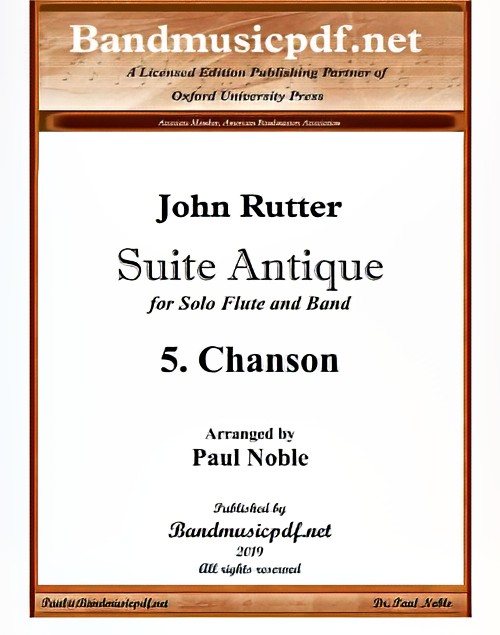 £95.00
£95.00Chanson (from Suite Antique) (Flute Solo with Concert Band - Score and Parts) - Rutter, John - Noble, Paul
Suite Antique is a 1979 concertante work by John Rutter that is written for harpsichord, flute and string orchestra. Rutter composed the piece, in six movements, for a concert at which Bach's fifth Brandenburg concerto was to be performed, and so decided to write the piece for the same ensemble. This arrangement for Concert/Wind Band and Solo Flute adheres to the original presentation, but is expanded for a full band accompaniment to the solo flute. The harpsichord is optional, being cued elsewhere, but may be performed as in the original score by either harpsichord or an electronic keyboard with a similar setting. A jazz drumset is optionally included in the fourth (jazz waltz) movement, and other percussion discretely added in other movements. It is exciting to hear earlier musical forms brought into today's music appreciation, and this setting of a flute solo with band is especially refreshing for both soloist and band.
Estimated dispatch 7-14 working days
-
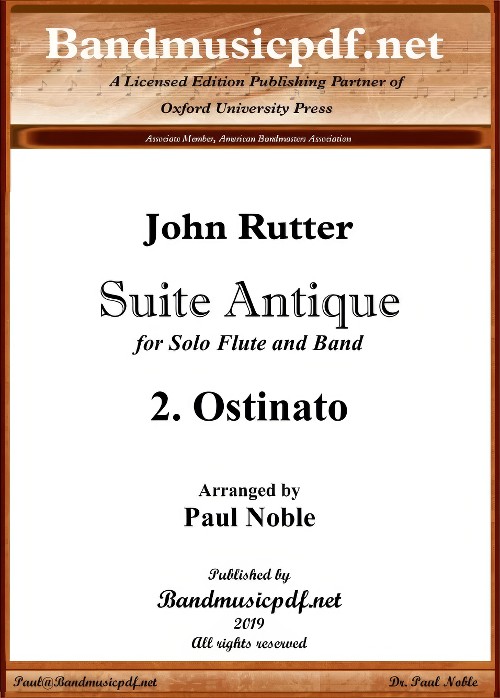 £90.00
£90.00Ostinato (from Suite Antique) (Flute Solo with Concert Band - Score and Parts) - Rutter, John - Noble, Paul
Suite Antique is a 1979 concertante work by John Rutter that is written for harpsichord, flute and string orchestra. Rutter composed the piece, in six movements, for a concert at which Bach's fifth Brandenburg concerto was to be performed, and so decided to write the piece for the same ensemble. This arrangement for Concert/Wind Band and Solo Flute adheres to the original presentation, but is expanded for a full band accompaniment to the solo flute. The harpsichord is optional, being cued elsewhere, but may be performed as in the original score by either harpsichord or an electronic keyboard with a similar setting. A jazz drumset is optionally included in the fourth (jazz waltz) movement, and other percussion discretely added in other movements. It is exciting to hear earlier musical forms brought into today's music appreciation, and this setting of a flute solo with band is especially refreshing for both soloist and band.
Estimated dispatch 7-14 working days
-
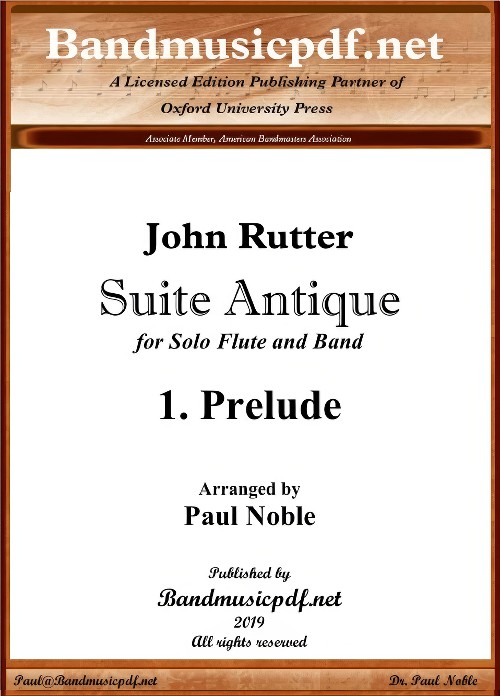 £75.00
£75.00Prelude (from Suite Antique) (Flute Solo with Concert Band - Score and Parts) - Rutter, John - Noble, Paul
Suite Antique is a 1979 concertante work by John Rutter that is written for harpsichord, flute and string orchestra. Rutter composed the piece, in six movements, for a concert at which Bach's fifth Brandenburg concerto was to be performed, and so decided to write the piece for the same ensemble. This arrangement for Concert/Wind Band and Solo Flute adheres to the original presentation, but is expanded for a full band accompaniment to the solo flute. The harpsichord is optional, being cued elsewhere, but may be performed as in the original score by either harpsichord or an electronic keyboard with a similar setting. A jazz drumset is optionally included in the fourth (jazz waltz) movement, and other percussion discretely added in other movements. It is exciting to hear earlier musical forms brought into today's music appreciation, and this setting of a flute solo with band is especially refreshing for both soloist and band.
Estimated dispatch 7-14 working days
-
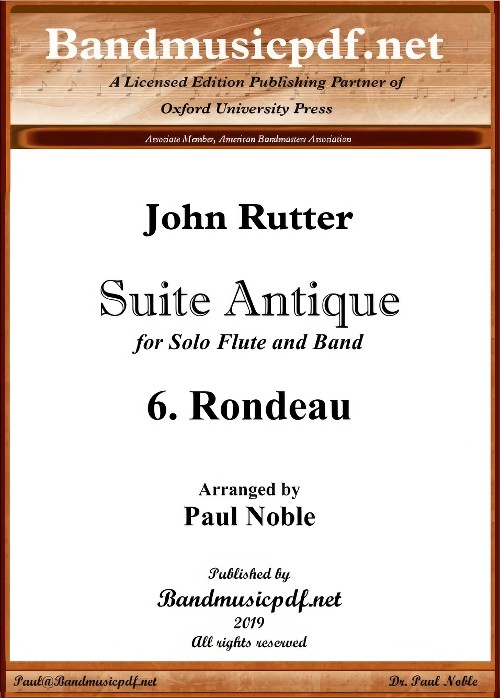 £110.00
£110.00Rondeau (from Suite Antique) (Flute Solo with Concert Band - Score and Parts) - Rutter, John - Noble, Paul
Suite Antique is a 1979 concertante work by John Rutter that is written for harpsichord, flute and string orchestra. Rutter composed the piece, in six movements, for a concert at which Bach's fifth Brandenburg concerto was to be performed, and so decided to write the piece for the same ensemble. This arrangement for Concert/Wind Band and Solo Flute adheres to the original presentation, but is expanded for a full band accompaniment to the solo flute. The harpsichord is optional, being cued elsewhere, but may be performed as in the original score by either harpsichord or an electronic keyboard with a similar setting. A jazz drumset is optionally included in the fourth (jazz waltz) movement, and other percussion discretely added in other movements. It is exciting to hear earlier musical forms brought into today's music appreciation, and this setting of a flute solo with band is especially refreshing for both soloist and band.
Estimated dispatch 7-14 working days
-
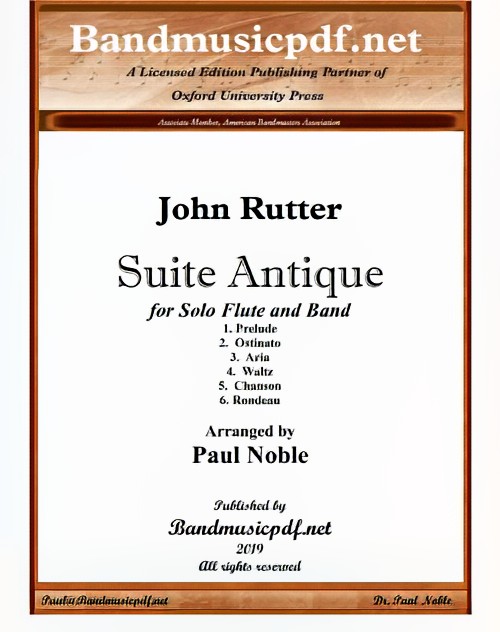 £395.00
£395.00Suite Antique (Flute Solo with Concert Band - Score and Parts) - Rutter, John - Noble, Paul
Suite Antique is a 1979 concertante work by John Rutter that is written for harpsichord, flute and string orchestra. Rutter composed the piece, in six movements, for a concert at which Bach's fifth Brandenburg concerto was to be performed, and so decided to write the piece for the same ensemble. This arrangement for Concert/Wind Band and Solo Flute adheres to the original presentation, but is expanded for a full band accompaniment to the solo flute. The harpsichord is optional, being cued elsewhere, but may be performed as in the original score by either harpsichord or an electronic keyboard with a similar setting. A jazz drumset is optionally included in the fourth (jazz waltz) movement, and other percussion discretely added in other movements. It is exciting to hear earlier musical forms brought into today's music appreciation, and this setting of a flute solo with band is especially refreshing for both soloist and band.
Estimated dispatch 7-14 working days
-
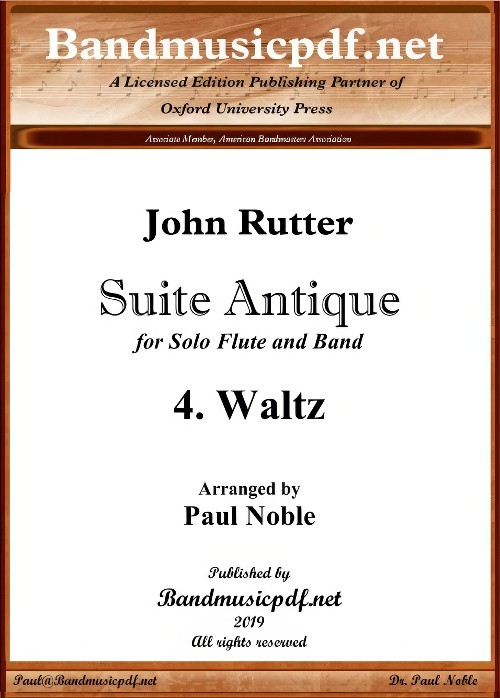 £110.00
£110.00Waltz (from Suite Antique) (Flute Solo with Concert Band - Score and Parts) - Rutter, John - Noble, Paul
Suite Antique is a 1979 concertante work by John Rutter that is written for harpsichord, flute and string orchestra. Rutter composed the piece, in six movements, for a concert at which Bach's fifth Brandenburg concerto was to be performed, and so decided to write the piece for the same ensemble. This arrangement for Concert/Wind Band and Solo Flute adheres to the original presentation, but is expanded for a full band accompaniment to the solo flute. The harpsichord is optional, being cued elsewhere, but may be performed as in the original score by either harpsichord or an electronic keyboard with a similar setting. A jazz drumset is optionally included in the fourth (jazz waltz) movement, and other percussion discretely added in other movements. It is exciting to hear earlier musical forms brought into today's music appreciation, and this setting of a flute solo with band is especially refreshing for both soloist and band.
Estimated dispatch 7-14 working days
-
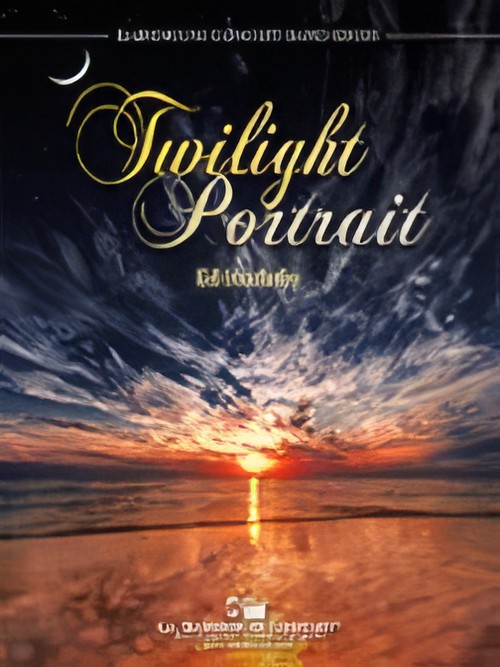 £74.00
£74.00Twilight Portrait (Concert Band - Score and Parts) - Huckeby, Ed
Looking for something different? This stunningly beautiful ballad was inspired by a series of photographs depicting the twilight times of sunrise and sunset. With flowing melodic lines and soaring countermelodies, "Twilight Portrait" provides a magnificent opportunity for your ensemble to develop and showcase a legato playing style, while presenting a striking image of musical lyricism. A video slideshow, featuring the photographs which inspired the work, is available for download so the twilight images can be presented in concert with the music as a unique multimedia event. Duration: 4.00
Estimated dispatch 7-14 working days
-
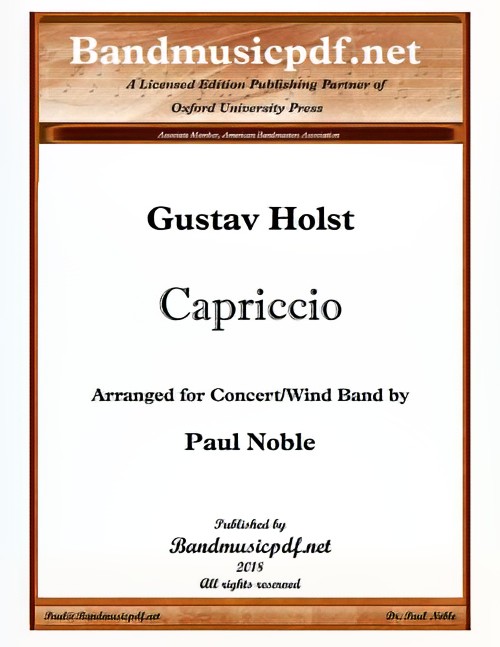 £140.00
£140.00Capriccio (Concert Band - Score and Parts) - Holst, Gustav - Noble, Paul
The following notes have been excerpted by the arranger from those presented in the Introduction by Imogen Holst, daughter of Gustav Holst: Holst wrote this work in the spring of 1932, while he was guest Lecturer in Composition at Harvard University. He had been asked by Nathaniel Shilkret to write 'a short radio piece, not longer than five or six minutes.' for a composers' series on folk music themes. Holst wrote to me on 13 May 1932, saying: 'On May 1 I started sketching a piece for Shilkret's Radio jazz band in New York. I finished the sketch on the 4th and the full score on the 8th... Shilkret wanted something on American airs but I've left them out because I prefer my own so he may reject the thing.' Shilkret was enthusiastic about the piece, but he was unable to use it for his series. 'I hate to give it up,' he told the composer, 'but I cannot play it because it is not based on a definite English or American folk theme.' Holst never revised his hurriedly-written work, probably because he had too many other things to write during the remaining two years of his life, when he was having to spend a good deal of his time in hospital. The autograph manuscript of his original full score is in the British Library, MS Add.47833. The work had no name: Holst referred to it either as his 'Jazz band piece' or as 'Mr. Shilkret's Maggot.' The score needed editing. There were gaps and patches, with incomplete dynamics and phrase marks. I made the version for orchestra and named it 'Capriccio' in spite of the viola's (now saxophone's) expressive opening, because from the moment of the marimba's first animated remark there can be no doubt about the mood of the music. - Imogen Holst (1968)
Estimated dispatch 7-14 working days
-
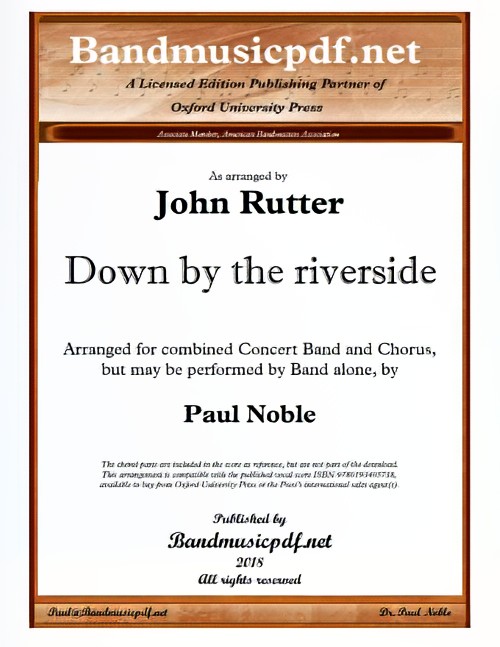 £110.00
£110.00Down by the Riverside (Concert Band with opt. Choir - Score and Parts) - Rutter, John - Noble, Paul
Down by the riverside is a spiritual that was sung by slaves in the South as a work song. It dates back to before the American Civil War. John Rutter's lively arrangement of this barnstorming American folk-song builds up from a quiet opening to a triumphant conclusion. This arrangement is a faithful adaptation of the original orchestration for chorus and orchestra, but it is arranged so that it may be performed by band alone. The style is an authentic toe-tapping early jazz creation that relates to the 'jitterbug' era, and the band arrangement is complete with an optional jazz clarinet solo as well as a rousing chorus by the sax section. The piano part is cued if needed. This is a perfect opportunity to get the entire band 'swinging', and could even entice a 'One mo' time!' finale.
Estimated dispatch 7-14 working days
